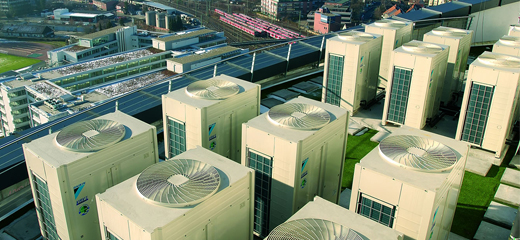
Key Trends in the Construction Market and the Growing Popularity of Multi-Zone Air Conditioning Systems
The main trends in the construction market today focus on minimizing costs while maximizing comfort and efficiency in executing construction plans. Buildings with fifty floors are no longer surprising, which raises the challenge of improving energy efficiency and maintaining both heat and cold within them. This can be achieved by reducing resource consumption and increasing the efficiency of every kilowatt of energy used. To address this, new thermal insulation materials are being developed, alternative energy sources are being explored, and new applications for the most energy-efficient equipment are being sought.
As a result, multi-zone air conditioning systems are gaining popularity, expanding their application in office buildings and industrial facilities.
What is a Multi-Zone System?
A multi-zone system is a solution for air conditioning multiple floors using one or several outdoor units connected to numerous indoor units. These outdoor units, placed on rooftops, basements, or technical floors, distribute refrigerant through a unified piping system made of copper pipes and refnet distributors. The number of indoor units can reach several dozen, and they come in various types, including cassette, ducted, ceiling-mounted, and wall-mounted units. The capacity of these indoor units varies according to specific building requirements and customer needs.
Thus, each room receives its own climate control system, tailored to its parameters based on the designer's calculations and the client’s specifications.
History and Evolution of Refrigerant-Based Air Conditioning Systems
Refrigerant-air systems first appeared in Japan in 1982. The first such system was introduced by Daikin Corporation under the registered name VRV (Variable Refrigerant Volume). Since this abbreviation was trademarked, other companies developing similar systems with the ability to redistribute refrigerant volume and capacity among units released their versions under different names.
Such equipment is manufactured by leading brands like:
-
Mitsubishi Heavy Industries (multi-zone systems marked as KX)
-
Mitsubishi Electric (City Multi)
-
Fujitsu General (VRF)
-
Haier (MRV)
-
GREE (GMV)
-
McQuay (MDS)
-
Sanyo (Eco-Multi)
-
LG (MPS)
-
Toshiba (MMS)
-
Midea (MDV)
In Russian-language sources, these systems are often referred to as "multi-zone systems," "variable refrigerant flow systems," or simply VRF systems (Variable Refrigerant Flow).
Initially considered an extension of split and multi-split systems, today VRF/VRV systems represent a separate and rapidly growing segment of the global air conditioning market.
VRF Systems in Residential and Commercial Use
In recent years, VRF systems (multi-zone systems) have become a popular choice for air conditioning in luxury apartments and cottages, particularly mini-VRV (VRV-S) solutions. These systems help preserve the aesthetic appeal of building facades while providing the best possible indoor climate control.
Like split and multi-split systems, VRF solutions consist of outdoor and indoor units. However, due to their advanced technology, they are often classified as central air conditioning systems. They can simultaneously maintain comfort in 4 to 48 rooms across an area of 100 to 1,000 square meters, effectively addressing both ventilation and air conditioning needs.
Advantages of VRF Systems
-
Variety of Indoor Units: VRF systems support wall-mounted, cassette, ducted, ceiling-mounted, and floor-standing units, making them suitable for rooms of any layout while preserving interior aesthetics.
-
Longevity: Unlike residential split systems that last 6-8 years, VRF systems are designed for 20-25 years of operation.
-
Energy Efficiency: They consume only 37W per square meter, which is 20-40% lower than traditional air conditioners.
-
Smart Energy Transfer: If some indoor units operate in cooling mode while others are heating, the system efficiently transfers excess heat between rooms, reducing energy consumption by up to 50%!
Y Refnet Joint for VRV/VRF Systems
Our company supplies refnet joint for installing multi-zone air conditioning systems (VRV/VRF systems) from various manufacturers. We can help select and offer distributors based on your preferences, requirements, and budget.